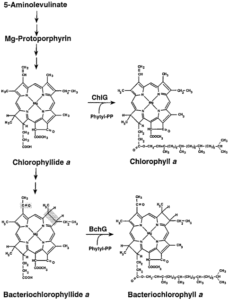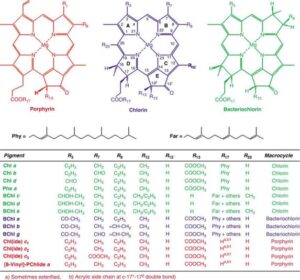Back to: MICROBIOLOGY 200 LEVEL
Welcome to class!
Hello there, brilliant mind! It’s a great day to learn something fresh and exciting. You’ve been doing so well—your consistency is powerful. Today, let’s talk about something that gives life its green glow and fuels nature’s energy-making magic: the Role of Pigments like chlorophylls and bacteriochlorophylls. Don’t worry—we’ll break it down in our usual fun, relatable, and Nigerian style. Let’s get right into it!
Role Of Pigments (Chlorophylls, Bacteriochlorophylls)
What Are Pigments?
Pigments are special coloured molecules that absorb light. In photosynthetic organisms (like plants, algae, and some bacteria), pigments are the front-liners in capturing sunlight and starting the process of photosynthesis. Without pigments, organisms wouldn’t be able to trap the sun’s energy to make food.

Think of pigments like the solar panels you see on rooftops in Lagos or Abuja—they soak up sunlight and help turn it into usable energy.
Chlorophylls – The Green Powerhouses
Chlorophyll is the main pigment in plants, algae, and cyanobacteria. It gives plants their green colour and is found inside chloroplasts, specifically in the thylakoid membranes.
There are two major types:
Chlorophyll a – found in all oxygenic photosynthetic organisms. It’s the primary pigment that starts the energy-conversion process.
Chlorophyll b – helps absorb light energy and passes it on to chlorophyll a. It’s like the assistant captain in a football team.
These pigments:
Absorb light, especially in the blue and red regions of the spectrum.
Reflect green light, which is why plants appear green to our eyes.
Transfer the absorbed energy to electrons, starting the process that eventually makes glucose.
Bacteriochlorophylls – The Bacterial Specialists
Some bacteria, especially those that don’t produce oxygen (anoxygenic photosynthetic bacteria), use bacteriochlorophylls instead of regular chlorophyll.
These include:
Purple sulphur bacteria
Green sulphur bacteria
Heliobacteria
Bacteriochlorophylls:
Absorb light at different wavelengths than chlorophyll a and b—often in the infrared region, which is not visible to our eyes.
Allow these bacteria to live and photosynthesise in low-light environments like the bottom of swamps, hot springs, or muddy riverbeds.
Do not produce oxygen during photosynthesis.
Think of bacteriochlorophylls as specialised torchlights that work in the dark corners where ordinary light doesn’t reach.
Why Are Pigments Important?
Without pigments:
Organisms cannot absorb sunlight for photosynthesis.
There would be no energy production, no glucose, and no oxygen (in oxygenic photosynthesis).
Life on Earth would not function as it does today.

In short, pigments are the bridge between the sun’s energy and living things.
Simple Example
Picture this: during NEPA blackout, your family uses solar panels to charge a power bank. The solar panel is like chlorophyll—it collects light energy. Without it, you can’t store power or turn on your fan. That’s exactly what chlorophyll and bacteriochlorophyll do—they collect sunlight and help convert it into usable energy for life.
Summary
- Pigments are coloured molecules that absorb light for photosynthesis.
- Chlorophylls (especially chlorophyll a and b) are found in plants and algae and give them their green colour.
- Bacteriochlorophylls are found in certain bacteria and allow photosynthesis in low-light, oxygen-free environments.
- These pigments start the energy conversion that leads to food production and, in some organisms, oxygen release.
Evaluation
- What is the main role of pigments in photosynthesis?
- Why do plants appear green?
- What is the difference between chlorophyll and bacteriochlorophyll?
- Name one organism that uses bacteriochlorophyll.
You did amazingly well today! Understanding how life captures the sun’s energy puts you among the sharpest minds. Keep up the great work—your future is bright like the sun itself! With Afrilearn by your side, every lesson is a step closer to greatness. See you in the next class, champion!
